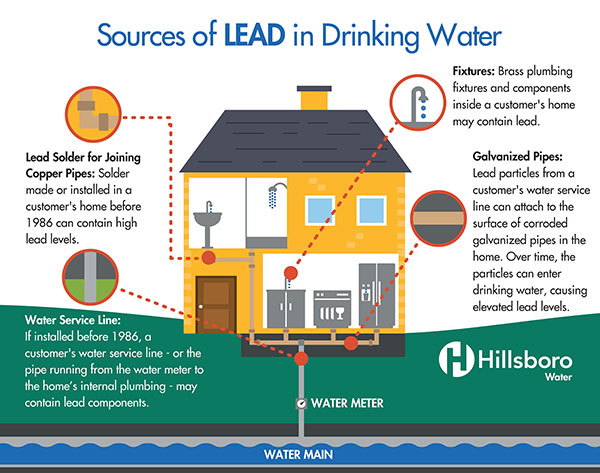The City of Hillsboro Water Department delivers safe, clean, and lead-free water to customers. Hillsboro’s water system has no known lead pipes or connections.
Sources of Lead in Drinking Water
The main sources of lead in drinking water are customer-owned lead pipes, plumbing fixtures, and water service lines.

- Lead solder for joining copper pipes: Solder made or installed in a customer’s home before 1986 can contain high lead levels.
- Water service line: If installed before 1986, a customer’s water service line – or the pipe running from the water meter to the home’s internal plumbing – may contain lead components.
- Fixtures: Brass plumbing fixtures and components inside a customer’s home may contain lead.
- Galvanized pipes: Lead particles from a customer’s water service line can attach to the surface of corroded galvanized pipes in the home. Over time, the particles can enter drinking water, causing elevated lead levels.
Lead can enter drinking water when customer’s plumbing materials break down or corrode.
Homes most at risk for lead in water are those generally built or plumbed between 1970 and 1985. Testing at the tap is the only way to know if the solder is leaching lead into your drinking water. Free lead-in-water testing kits are available to qualifying customers located in Hillsboro Water's service area. See Free Lead-in-Water Testing Program section below.
Lead-Based Paint
In addition, lead-based paint and lead contaminated dust are the most hazardous sources of lead for children residing in the United States. Lead-based paints were banned for use in housing in 1978. All houses built before 1978 are likely to contain some lead-based paint.
Lead paint is still present in millions of homes, sometimes under layers of newer paint. If the paint is in good shape, the lead paint is usually not a problem. Deteriorating lead-based paint (peeling, chipping, chalking, cracking, damaged, or damp) is a hazard and needs immediate attention.
It may also be a hazard when found on surfaces that children can chew or that get a lot of wear-and-tear, such as:
- Windows and windowsills
- Doors and door frames
- Stairs, railings, banisters, and porches
If lead is present, elevated levels can cause serious health problems, especially for pregnant women and young children.
